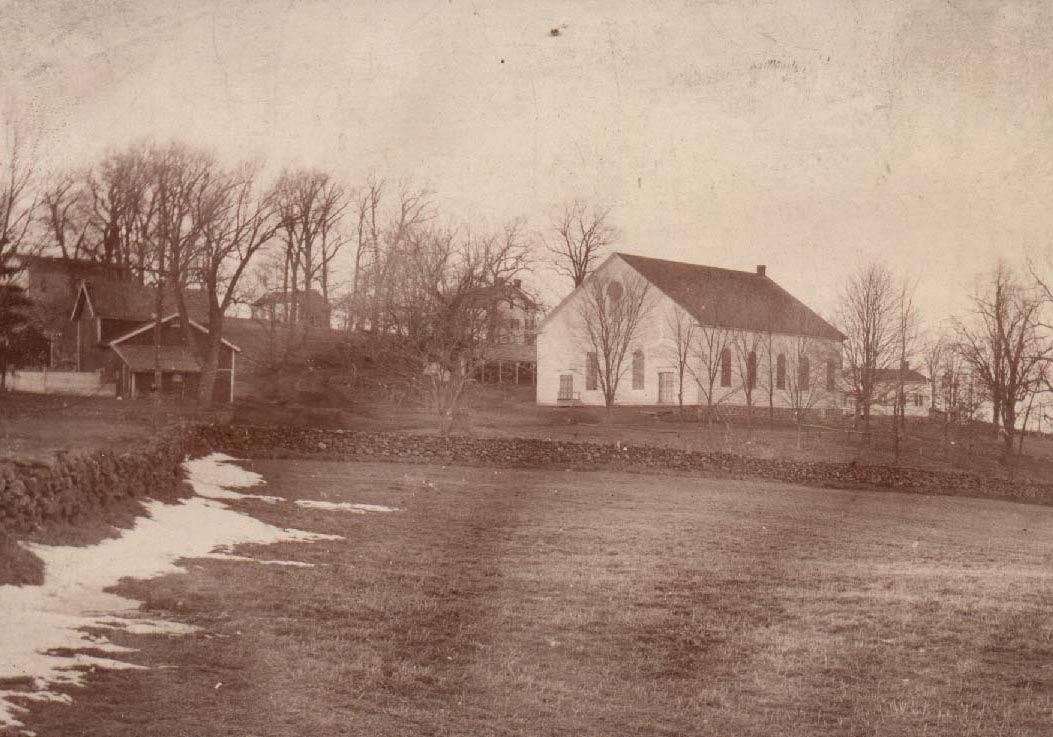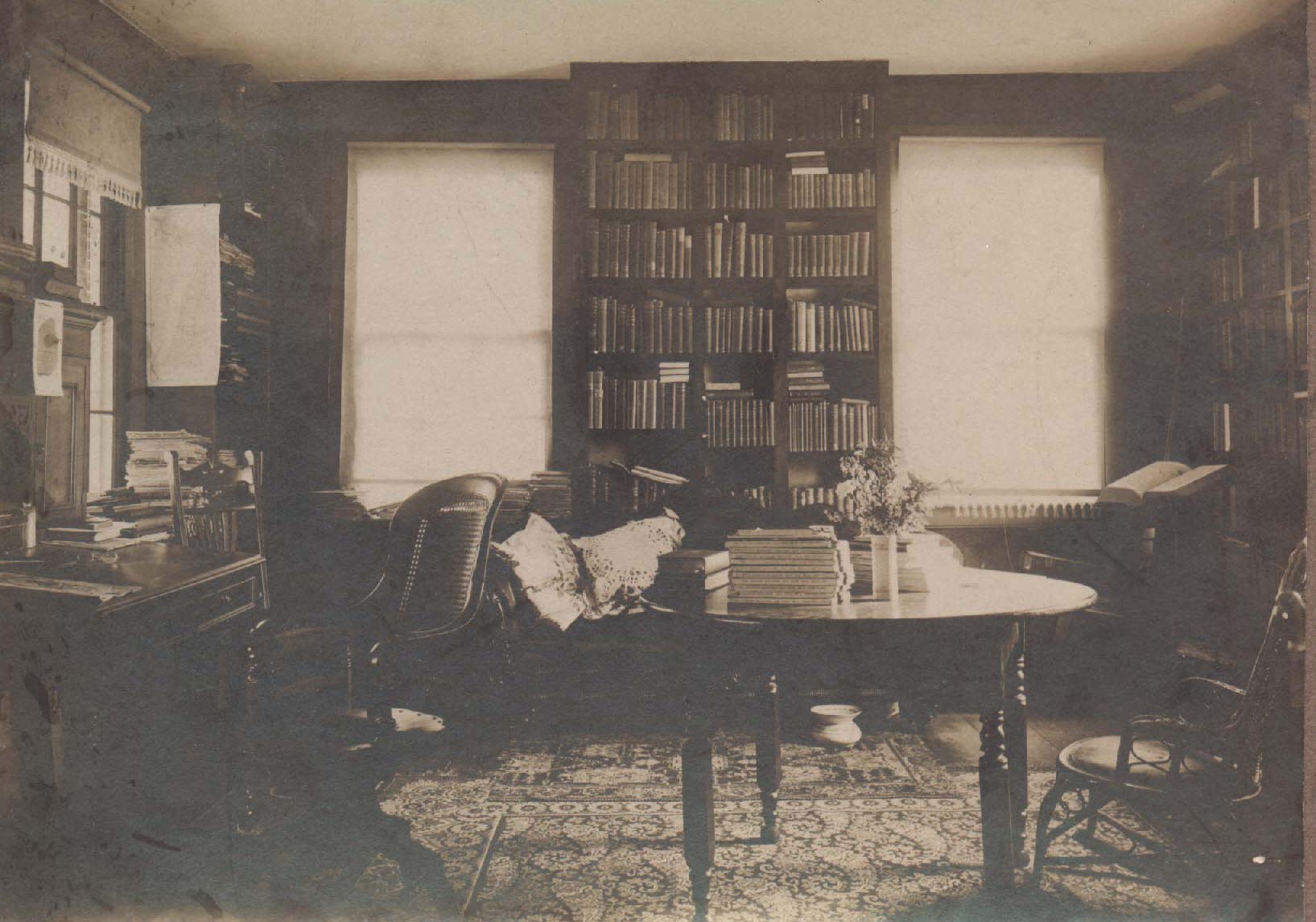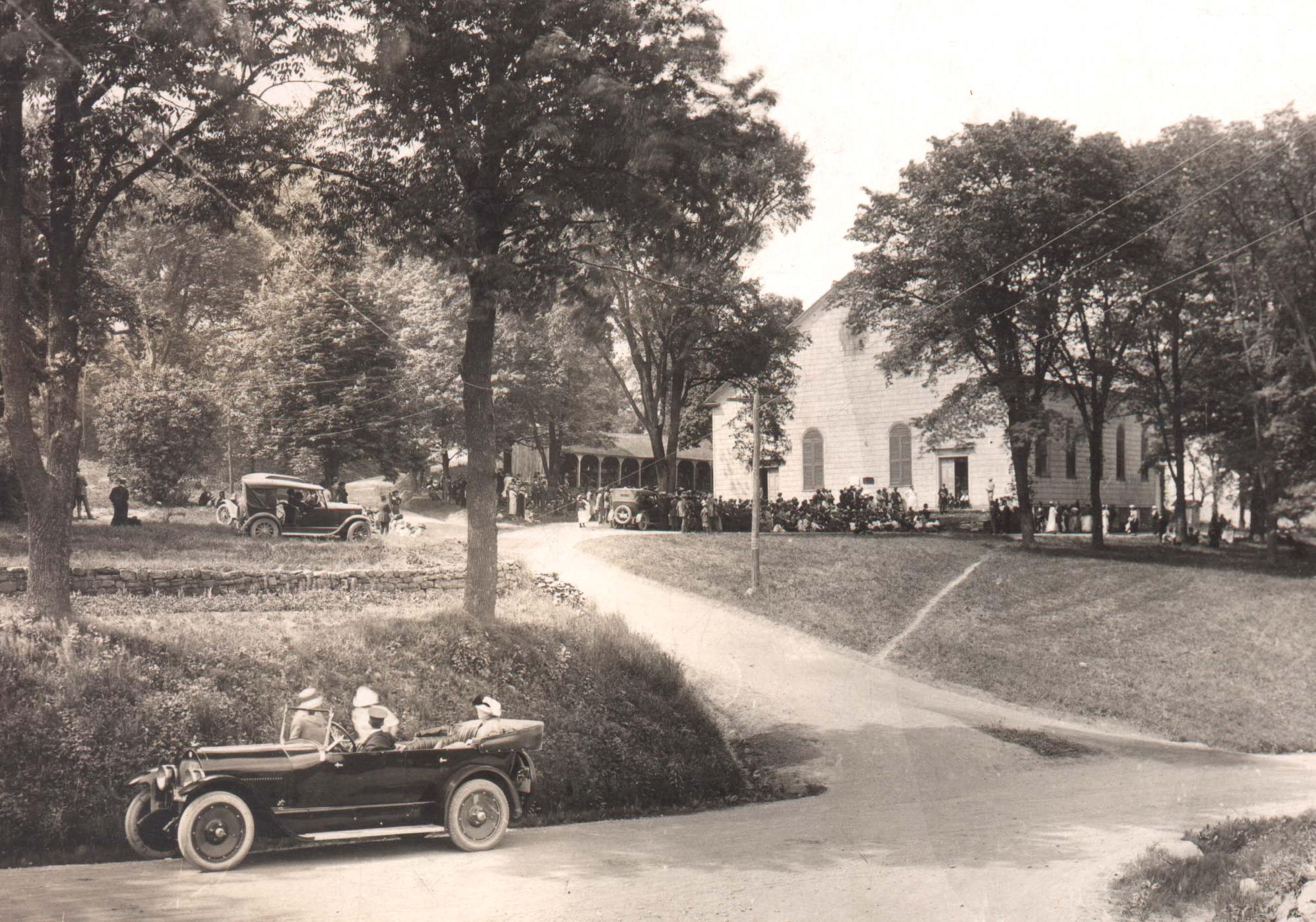BLOOMING GROVE
UNITED CHURCH OF CHRIST










CHURCH HISTORY
The venerable Blooming Grove Church is an historic gem with a unique architectural twist.
The Blooming Grove United Church of Christ began as a Presbyterian church around 1758, became a Congregational church in 1833 and joined the United Church of Christ in 1961. The exact date the church was founded is lost to history, although written records begin in 1758 when Jacob Blackwell deeded a piece of land to the congregation for the purposes of building a meetinghouse (church building), burying ground, and a schoolhouse.
A meetinghouse was built in 1759, probably from wood cut on the property. This first building served the congregation until 1823 when a new meetinghouse was built to accommodate a growing congregation. The building’s dimensions are 75 x 63 feet, and foundations enclose the burying ground where three of the church’s earliest pastors are buried. The graves, with their gravestones intact, are accessible through a trap door in the sanctuary floor.
The side walls are covered in the original “putty” finish, also known as “marbleized plaster”. Another unique feature of the building is that it has no interior supports or pillars. The method of constructing trusses, known as king and queen posts, creates an open feeling in the sanctuary. Acoustically vibrant, due to its structure, the church sanctuary regularly serves as performance space of performing arts organizations. BGUCC has been the rehearsal home of Orange County’s Classic Choral Society since 1959.
The Blooming Grove Church is listed on the National Register of Historic Places since 1996.
______________________________________________________________________________________________________
Thanks to Michael Matsler for the following description reproduced from “Like Finding an Heirloom in your Attic: Blooming Grove Church, a Local Jewel.”
The venerable Blooming Grove Church is an historic gem with a unique architectural twist. It was built in 1823 on the site of the first church from 1759 on a rise overlooking the King’s Highway, now called Route 94. From outside it looks like a classic rural New England meeting house with steep gabled roofline, white-shingled sides and tall rounded windows. Step inside and you’ll see why in 1996 it was enrolled in the National Register of Historic Places.
It is only a short walk from the 21st century to the Victorian age. You enter a vast open space illuminated by the natural light of the morning sun sparkling through fifteen Palladian windows. The inside of the church – 63 feet wide by 75 feet long – has no pillars or columns blocking the view. The roof over the white-plastered ceiling 27 feet above the front pews is held up by a hidden series of posts and beams. Referred to as the King and Queen post design, only one other church in the country shares this rare architectural feature. No other church is known to share another feature: the marble-like appearance of the plaster walls. It was the secret recipe of the craftsman from the village of Florida who applied the special glazing around 1823 who took his secret to his grave.
Speaking of graves, there are three in the cellar of the church. They used to be just outside the old foundation wall and were allowed to remain when the new, larger church was put up. Rev. Enos Ayres, the first pastor, died in 1762 and his successor Rev. Samuel Parkhurst in 1768, never dreaming New York would morph from British colony to American state within a generation. Rev. Bradner died in 1804.
Stand at the back of the church and savor the atmosphere, redolent of candles and well-worn wood with a whiff of grandma’s antique furniture and chiffon wedding gown. Looking towards the pulpit on the opposite wall, your eyes travel over the varnished pine box pews painted white inside capped with cherry. Their side doors rest on hinges almost 200 years old. The pews grace both sides of the center aisle and the side walls of the church. The sloping floor descends down toward the pulpit on its raised dais behind which the grand pipe organ reigns, its tall, slim air tubes ascending upwards like so many gothic spires.
The pipe organ was installed in 1902 as a gift of David H. Moffat, Jr. who donated the library bearing his name in Washingtonville. He left Orange County in 1851 at the age of twelve to seek his fortune. He became a wealthy financier and railroad baron out West. Anyone familiar with Colorado’s Rocky Mountains or railroad history will know of the Moffat Tunnel.
David’s ancestors going back to the 18th century were members of this Church, as well as Bethlehem Church in today’s New Windsor where the clan’s patriarch Samuel Moffatt and his wife are buried.
On your left in the middle of the southeast wall is a stunning stained glass window glowing in the morning light, radiating hues of gold, green, blue and purple. Purple, the color of honor, the memory of sacrifice. Athwart the Palladian arch of the window is the single word: Patriotism.
At the bottom of the window in black lettering are the names of a dozen young men. No cities are named after them. No bridges, no highways, no schools. Few outside their direct descendants know who they were or what they did. They did not write books, or magazine articles or make speeches. But they gave, several the last full measure of devotion. As did thousands of others, in quiet anonymity. Newton Brewster. Charles Brewster. Chadwick Gerow, Malcolm Tuthill. David Hudson…. “It is our acts, not our words, that count”, we can read above their names.
The beautiful window was dedicated on Saturday, June 20, 1918 not 15 months after America’s entry into the Great World War. Within only three months one of them was to give up his life on the fields of France, only seven weeks before the Armistice. The 1st lieutenant of Company B, 105th Infantry wrote the sad news to his mother. In the morning of September 29, 1918 Sgt. Gerow was struck by German shelling as his company was about to go over the top of the trenches.
The Revolutionary War saw numerous members of the Blooming Grove church distinguish themselves by their service. Jesse Woodhull cast a long shadow in patriot Orange County: sheriff, member of the New York Provincial Congress, militia colonel. His brother General Nathaniel was killed at the Battle of Long Island in September 1776.
Another parishioner of the church was destined to become famous after the War before sinking into oblivion during the Reign of Terror capping the French Revolution. He was a French nobleman who married an American in 1769, living on their farm down the King’s Highway towards Chester, just west of today’s Roe’s Orchards. A plaque marks the site. Today only his stone smoke-house remains, the foundation of his house now occupied by a later 19th century usurper.
Wishing to remain neutral, Michel-Guillaume Hector St. Jean de Crèvecoeur, persecuted by Tories and Patriots alike, fled to New York City, was imprisoned by the British, then released and wound up back in France after he and his oldest son Ally survived a shipwreck off the coast of Ireland. He authored a popular book about America as the new Eden, and was introduced through relatives and friends into the High Society of intellectual Paris. He returned to New York on November 19, 1783 as the first French Consul to the new state, just in time to witness the evacuation of the British Army and the triumphant entry of Washington and his men. Crèvecoeur’s traveling companion was John Thatcher, Ambassador John Adams’ secretary, carrying the original Treaty of Paris to present to the Congress.
Thanks to Crèvecoeur the state Assembly legalized Catholicism in 1785 and he was one of four trustees to the first Catholic church in New York, St. Peter’s on Barclay and Church Streets, where daughter Fanny was married in April 1790 to a French diplomat. Notables such as Thomas Jefferson were in attendance. The Vermont town of St. Johnsbury is named after him, through the suggestion of his friend Ethan Allen.
In November 2013 the Patriotism window was given a colorful sibling. The new stained glass window graces the back, northerly wall of the church. It honors all veterans and seven service branches: National Guard, Merchant Marine, Coast Guard, Air Force, Navy, Marines and the Army. Across the top is the word “Honor” below the flame of divine purity and wisdom. At right flank is the dove of peace and at left flank the oak leaves of valor, virtue and faith. Parishioner Al Bull, whose ancestors Sarah Wells and William Bull built their stone house nearby in 1722, is a Vietnam veteran and his father Albert was a two-time Purple Heart recipient serving in World War II. Looking at the pews, you can sense if not see the spirits of these early pioneers and their descendants, silhouettes of memories faded but not forgotten.
Blooming Grove Church’s history and its unique stained glass windows entitle it to the reputation of being the Veteran’s Church of Orange County. The congregation has taken on the mission of helping local veterans in need, and in keeping alive the memories of those who serve our country.
Because of the church’s beauty, its accommodating pews, and its wonderful acoustics, musical concerts open to the public take place throughout the year. The Classic Choral Society of Orange County has long made its home base here. The church is available for other events as well.
Anyone interested in visiting can always drop by for service on Sunday, or by simply contacting the church through its website under Blooming Grove United Church of Christ.

On the WWI window “Honoring Those Who Serve”
Joseph J. Genthner was called to be pastor of the Blooming Grove United Church of Christ on October 29, 1917. During his brief pastorate of about eighteen months there was a flurry of activity initiated by Genthner himself. Genthner initiated an ongoing series of programs and lectures to bring new people to the church. He worked at providing programs of current interest. The “Great War” (World War I) was of great interest because of our recent entry into the fighting. The programming included a lecture on November 10 by Rev. Wilbert W. White, D.D., Ph.D. on “The Religious View Point of the War.”
The highlight of Genthner’s brief pastorate was the dedication of the service window in the sanctuary in 1918, A contemporary newspaper article about the dedication claimed it to be the first such window in the country. Oddly, the date is not recorded. An invitation to events around that time list a program on June 16 celebrating the installation of the window, and a concert on June 21, with the notice of the window dedication between the two indicating that the date would be announced as soon as possible. A newspaper clipping indicates that the dedication was held on a Saturday, which would make Saturday, June 20 the most likely date. Instead of a memorial window Genthner planned a window to honor Blooming Grove residents who took part in the war. The residents were:
Newton Brewster
Charles Brewster
Chadwick Gerow
David Hudson
Hezekiah Lord
William Mallon
Frank Montenaro
Dr. Charles Reed
Charles Shons
Raymond Seaman
George Stead
Malcolm Tuthill
Records from the time do not exist, so it is not possible to tell how the window was financed. Most likely it was financed by private donations.
On the day of the dedication of the window the keynote speaker, Governor Charles S. Whitman, was entertained at a couple of local homes. A parade began at the Moffat Library in Washingtonville and proceeded down Route 94 to the church. In the sanctuary there is a large framed collage of photographs and programs related to the day. Unfortunately the photographs have deteriorated, with parts of the photos sticking to the backside of the glass. Enough remains, however, to get a sense of the excitement and pageantry which must have been palpable. The dedication was in every way a community event, with parade participants including the Home Defense Leagues from Washingtonville, Cornwall, Chester, and Tuxedo Park, the Red Cross, the Monell Engine Company, the Daughters of the American Revolution, the Grand Army of the Republic (the fraternal organization for Civil War veterans), and other community organizations.
A significant historical event that took place during Genthner’s brief pastorate was the Spanish Flu pandemic of 1918-1919. Community celebrations and commemorations such as the window dedication would have been unthinkable during this devastating epidemic. Worldwide it killed an estimated 20-40 million people. It arrived in our area during the week of September 14-21 according to the U.S. Census Bureau map of the spread of the disease. Response to the pandemic was overshadowed by the winding down of the war. By fall, however, it could not be ignored. Every part of the country was affected to varying degrees. It spread across the rest of the world affecting everyone indiscriminately.
According to oral history, Genthner’s pastorate came to an abrupt end in the spring of 1919 when long-time church members began to think that they had heard many of Genthner’s sermons before. It came to light that he had discovered a box of Warren Hathaway’s sermons in the basement of the parsonage and helped himself, reading them on Sunday mornings instead of composing his own sermons. Needless to say, Genthner was strongly invited to resign.
.